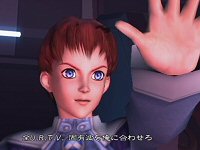The first Xenosaga game rocked my socks off, and then hit me upside the head with a sock full of rocks. It's true. Since it's only a small part of an evidently-huge tome, you had to expect a new installment to rear its head in the near future. Here it is, scheduled for a Q1 2005 release. It doesn't just continue the story, but refines and reinvents much of the original.
Moving Movies
Xenosaga Episode I had a massive amount of movies -- over seven-and-a-half hours worth, which is longer than a lot of games out there. Some people complained that this was overkill, though most enjoyed every minute of it. Episode II tries to appease both schools of thought. This time out, there is only five-and-a-half hours worth of cinemas, but Namco says it actually contains more story.
This title starts immediately after the previous installment ended. However, Xenosaga Episode II is able to stand on its own, making it accessible to you poor souls who didn't have a chance to play through the first installment. Unlike Xenosaga Episode I, which mostly took place in spaceships, this one branches out to more outdoor environments, such as cities and ruins.
Different Character
Returning are many of the strong characters that made Xenosaga such an epic role-playing game, such as Shion, KOS-MOS, and Ziggy. The youthful Junior plays a larger role than before, as well. Looking at the pictures, though, one can tell that things are not identical. In fact, Monolith has made drastic changes to the character models.
Characters now look more mature, designed to better capture their ages and personalities. The old models had difficulty conveying emotion. The new ones are more detailed, and you can really see what they're going through by looking at their faces. Another reason for the switch is that the first game was designed to target a specific market: hardcore anime freaks in Japan. When the game was a success in America, the decision was made to broaden the appeal.
Battle Better
Things have been tightened up in the combat department. Actions happen faster, due to feedback stating some attacks just took way too long to be executed -- especially those that were used with relative frequency. Basic attacks now happen in the blink of an eye, helping things move along at a steady clip.
Team members can be traded at will during battles, and they can even double up for eye-popping tag-team attacks. These are individually found throughout play. Movement has been expanded beyond the simple front- and back-line shifts. Now, you can actually switch to behind enemies. This not only helps you avoid major attacks, but allows you to inflict more damage.
Other additions give you the chance to put a bigger hurting on adversaries. Bosses have zones; hitting different buttons target different zones. You won't know which zone is the right one to attack until you experiment a bit, but once you figure it out for one enemy type, you'll know for the next clone. Breaks shatter boss defenses, and dish out 150% damage. There's even more pain dealt out if you use a character that can lift a monster up into the air.
Boost was used to string major attacks together for major results. In this installment, boost is carried over from battle to battle. It's definitely a good idea to save them up for the numerous boss battles. With a little strategy, you can take out the game's big bad boys a lot easier.
With its first entry, Xenosaga solidified itself as a major player in the RPG scene. Episode II takes things to the next level, and will make a serious bid for the top spot of role-players. Jenseits von Gun und Bose means "beyond good and evil," and this game at least looks to hold true to the first half of that statement.






